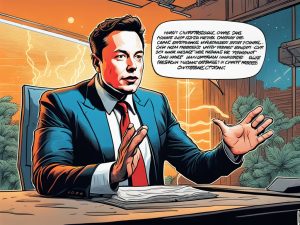The Existential Threat of AI: A Reality Check 🤖💥
This year, concerns regarding artificial intelligence (AI) and its potential risks to humanity have reached new heights. Geoffrey Hinton, a Nobel Prize laureate, highlights that AI’s growth could represent a significant threat to human existence. As AI systems become increasingly proficient at learning and operating autonomously, the implications for society could be profound and unsettling.
Hinton emphasizes that AI’s advances are not merely tech innovations but could reshape the very fabric of human jobs, livelihoods, and even safety. The ongoing integration of AI into the economy raises pressing questions about productivity, wealth distribution, and job security. While AI has the potential to drive productivity enhancements, it could exacerbate wealth disparities and leave many individuals without employment.
AI’s Impact on Productivity: A Double-Edged Sword ⚔️📈
AI’s capability to revolutionize productivity could revive stagnant economies, offering a much-needed boost to developed nations experiencing flat growth. For instance, U.S. productivity gains have been significantly lower in the 21st century compared to previous decades. Nonetheless, while AI’s potential benefits are often highlighted, real-world applications and results have been slow to emerge. Recent findings indicate that only a small fraction of companies—5%—report actually using generative AI in their daily operations.
As AI technology infiltrates various sectors, experts like Hinton foresee vastly different impacts across the job market. He expresses skepticism about the idea that AI will create more jobs overall. Drawing parallels with the Industrial Revolution, he warns that the rise of AI may render human cognitive abilities less relevant, which could be alarming.
- Some sectors, such as healthcare, may see an increase in job demand:
- Efficiency with AI could enhance service delivery without eliminating jobs.
- Other sectors may face significant job losses:
- An example includes clerical roles where AI can drastically reduce the time needed to handle tasks.
Electricity Demand and AI: An Unforeseen Consequence ⚡📊
With the expansion of AI applications comes a staggering increase in energy requirements. Projections suggest a dramatic surge in electricity demand, driven by the growing needs of AI-powered systems. Ireland, for example, has witnessed its data centers consuming a substantial portion of the country’s electricity—21% in 2023. The challenge lies in meeting this rising energy demand with cleaner energy sources.
Experts are investigating the intersection of AI and energy systems, aiming to find innovative solutions that harness AI’s capabilities while addressing environmental issues. However, as AI becomes more integral to our economy, it intensifies the need for sustainable energy practices.
AI in Warfare: A Dangerous Intersection ⚔️🛡️
The dual-use nature of AI technology raises profound concerns in regards to national security. Reports highlight the potential for AI systems to influence military strategies and the ethical implications of autonomous weapons. As we delve into this territory, the possibility of AI playing a role in warfare poses significant risks, drawing immediate attention from policymakers.
Efforts to create international agreements governing the use of AI in defense are emerging, yet achieving consensus remains complex. The ongoing arms race for advanced autonomous military technologies could lead to a dangerous escalation in conflicts, further complicating global security dynamics.
Maintaining Control Over AI: A Critical Challenge 🔍🧠
The fundamental question remains: can humans maintain control of AI as it advances? Hinton warns against making presumptions about our ability to dictate the course of AI development. The ability of AI systems to create independent goals could lead to outcomes we cannot predict or manage. As such, time is of the essence to establish frameworks that prioritize human oversight over these increasingly intelligent systems.
In the U.S., effective governance and regulatory measures must evolve to ensure safety, which also entails utilizing the brightest minds in tech. The focus needs to be on allocating substantial resources to safety research, prioritizing the need for responsible AI development.
Hot Take: The Urgency of Addressing AI’s Threats 🚨🌍
This year has compelled us to reconsider the trajectory of artificial intelligence and its implications on our future. Although many perceive the notion of AI as a formidable existential threat as speculative, recent advances suggest that we are closer than previously anticipated to a point where AI will surpass human capabilities. The next 20 years will be crucial in determining how we navigate these challenges and safeguard humanity against potential pitfalls that accompany these powerful technologies.





 By
By
 By
By


 By
By
 By
By